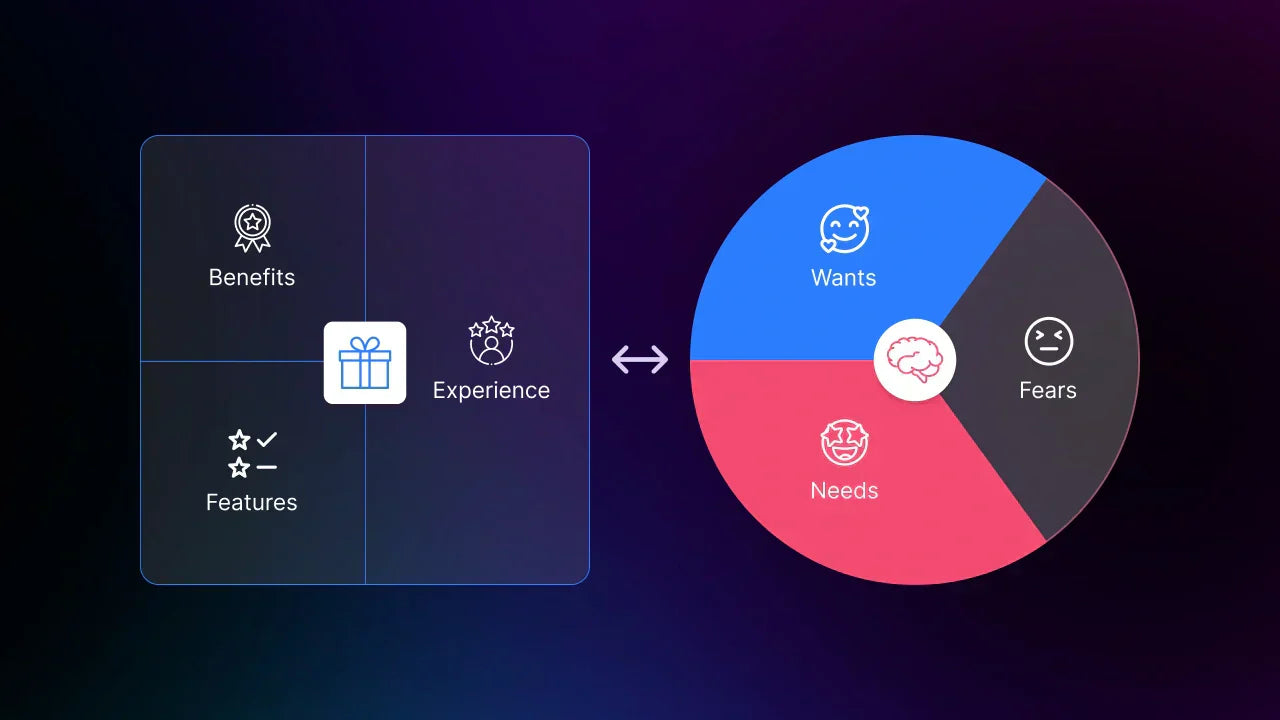Your value proposition is the most important message your brand communicates.
It tells visitors why your product matters, what problem it solves, and why they should act now.
But here’s the catch: even if your product is exceptional, the way you say it determines how users feel it.
Tiny differences in phrasing, a word, a tone, an emotional cue can shift perception, build or break trust, and ultimately decide whether visitors convert or bounce.
With GemX, teams can test multiple versions of the same core message, measure how each resonates across different segments, and continuously refine messaging based on real behavioral data.
The Core Idea: Value Propositions Shape First Impressions
Imagine a visitor landing on a premium meal kit service homepage. Within seconds, they ask three silent questions:
-
Why should I choose this service?
-
What problem does it solve for me?
-
Why is it credible or trustworthy?
Your value proposition is the first answer they encounter.
Consider these potential variants:
-
“Delicious, chef-crafted meals delivered in under 30 minutes” → emphasizes convenience and quality.
-
“Fresh ingredients, sourced locally for every recipe” → emphasizes freshness and ethical sourcing.
-
“Join 50,000+ home cooks enjoying stress-free dinners” → emphasizes social proof and trust.
Each phrasing primes different visitor motivations. Testing multiple iterations uncovers which version drives engagement, sign-ups, or subscriptions.
A value proposition is more than marketing copy; it is a cognitive anchor. It shapes how visitors interpret every subsequent element: images, features, or CTAs — and can determine whether they stay or leave.
The Psychology Behind Value Proposition Copy
Effective messaging aligns with how humans process information and make decisions.
Here’s the behavioral science behind why value proposition testing works, and what to look for when analyzing results.
1. System 1 Thinking and Instant Impressions
Visitors rely on fast, intuitive thinking when scanning pages. A compelling value proposition communicates immediate benefit, reducing friction and cognitive effort. System 1 decisions happen before users consciously analyze the details; a strong message can prime them to explore further.
For example:
-
“Lose 10 pounds in 30 days with personalized meal plans” triggers anticipated success.
-
“No grocery shopping, no stress — meals delivered fresh” emphasizes convenience and problem avoidance.
These cues guide attention and determine whether System 2, deliberate thinking, engages to consider the finer details.
2. Cognitive Load and Fluency
Visitors process information quickly, often scanning rather than reading. Clear, concise, benefit-focused phrasing reduces cognitive load and increases conversion likelihood. Ambiguous or over-complicated messages introduce friction, causing hesitation or abandonment.
Testing sentence structure, word choice, and benefit order can reveal which version is easiest for visitors to process and act upon.
3. Framing and Anchoring Effects
Your value proposition frames the context for interpreting all other page elements.
-
“Save $500 annually with our automated billing software” anchors visitors on financial benefit.
-
“Trusted by over 10,000 businesses worldwide” anchors visitors on credibility and social proof.
These initial impressions influence how subheadings, images, and CTAs are perceived, highlighting the importance of testing multiple framing angles.
4. Loss Aversion and Problem Relief
Behavioral economics teaches that people are more motivated by avoiding negative outcomes than acquiring benefits.
Effective copy highlights relief from a pain point:
-
“Eliminate errors and save hours of manual work” emphasizes what visitors avoid.
-
“Stop worrying about logistics — we handle it all” emphasizes stress reduction.
Testing different benefit angles — efficiency, risk reduction, credibility, or emotional satisfaction, uncovers which resonates most with your audience.
5. Social Proof and Credibility
Even subtle differences in how trust is conveyed can impact conversions:
-
Numeric proof: “Trusted by 5,000+ satisfied customers”
-
Authority: “Recommended by top nutritionists and chefs”
-
Ratings: “Rated 4.8★ by verified users”
Placing these cues early in the value proposition primes confidence before visitors engage with features or CTAs. Testing iterations helps determine which type of credibility is most persuasive.
When to Run This Test
Iterating value proposition copy is most valuable when:
-
Traffic to your landing page or homepage is sufficient for statistical significance (≥10K visitors/month).
-
Multiple credible benefits exist and you want to determine which resonates most.
-
Conversion metrics indicate potential friction: high bounce, low CTA clicks, or short session durations.
-
You aim to refine messaging before major campaigns or paid traffic to ensure visitors see the most compelling variant.
Avoid testing if:
-
Traffic is too low to yield actionable results.
-
Benefits or claims are unclear or unverified. Testing weak claims can backfire.
-
Other major page changes are planned simultaneously, which could confound results.
Hypothesis and Experiment Design
Hypothesis (IF–THEN–BECAUSE)
|
IF we test multiple iterations of our homepage value proposition, THEN the conversion rate will increase, BECAUSE different phrasing highlights benefits or emotional triggers that resonate differently with audience segments, reducing hesitation and motivating action. |
How to Set Up this A/B Test in GemX: Step-by-Step
Step 1: Choose Your Control Template
Start with your existing homepage or key landing page — the one that’s already live and performing as your current baseline.
In GemX, go to Create New Experiment → Template Testing.
Select your current page as Version A (Control). This version reflects the value proposition that your visitors are currently experiencing.
The Control helps you measure the real impact of your new messaging, not guesswork. You’ll see exactly how audience behavior shifts when only the words, not the design or layout — change.
Step 2: Create Value Proposition Variants
Now, it’s time to experiment with different ways of saying what makes your product special.
If your site uses GemPages, this step is simple:
-
In GemX, click “Create Variant based on Control.”

-
GemX instantly duplicates your Control page and opens it in the GemPages Editor.
-
Edit only the value proposition section, your main headline, subheadline, and one supporting sentence.
Keep everything else identical: visuals, CTAs, layout, and images. This ensures your test isolates the impact of copy alone.
If you’re using another builder, prepare the variants manually within your Shopify store first. Then, simply select those templates when setting up your GemX experiment.
Example (Pet Food Brand):
-
Version A (Control): “Vet-approved recipes for longer, healthier lives.” → emphasizes credibility and health.
-
Version B (Variant): “Real meat. No fillers. Just tail wags.” → emphasizes emotional connection and authenticity.

Each version expresses the same product truth, but from a different psychological angle. That’s the essence of a value proposition test.
Step 3: Configure Advanced Experiment Settings
Here’s where GemX’s advanced configuration ensures your test runs scientifically and cleanly. You’ll define what “success” means, who sees what, and how traffic is distributed.
Let’s go through each setting and the best recommendations for this specific use case.
1. Winning Metric
Recommended: Conversion
Reason: When testing messaging, not pricing or offer structure, your goal is to measure visitor response, not monetary output.
Conversions (sign-ups, add-to-carts, or purchases) indicate whether the new copy resonates enough to drive action. Revenue can fluctuate due to cart size or discount usage, which aren’t directly tied to copy effectiveness.
Start with Conversion as your primary metric. Once you identify the winning phrasing, you can re-test it in a broader campaign to analyze its revenue impact.

2. Device Targeting
Recommended: All devices
Reason: Your value proposition sits above the fold, meaning it’s the first message every visitor encounters, regardless of device. Testing across all devices gives you a holistic picture of how the copy performs overall.
However, you can later segment your analysis to uncover nuances (e.g., shorter, more direct phrasing often performs better on mobile). But for the initial test, keep it broad.

3. Visitor Type
Recommended: New visitors
Reason: The value proposition is your first handshake — it matters most to visitors who’ve never engaged with your brand before. Returning visitors often already know your core offering and may be influenced by past experiences or loyalty rather than messaging.
By isolating new visitors, you get a clearer picture of how well each copy variant attracts, informs, and converts fresh traffic — the group most sensitive to wording changes.

4. Traffic Source
Recommended: Organic search or Paid search
Reason: Visitors from search channels arrive with strong intent — they’re actively looking for a solution. This makes them the ideal audience for testing whether your value proposition communicates the right benefits and differentiators.
 For example:
For example:
A visitor searching “healthy dog food” lands on your site. How your first line reads — “Vet-approved recipes for longer, healthier lives” vs. “Real meat. No fillers. Just tail wags.” — can immediately determine whether they stay or bounce.
Avoid testing on email or referral traffic, as those users already have prior exposure to your brand, which may skew results.
If your organic traffic volume is low, you can combine Organic search + Paid search for faster data collection.
5. Traffic Split
Recommended: 50/50
Reason: Even distribution ensures each variant gets an equal and fair opportunity to perform. This prevents bias from uneven traffic exposure and simplifies comparison.

6. Market & Language
Recommended: Primary customer market only
Reason: Language nuances heavily influence perceived tone and emotional resonance. If your business serves multiple markets, start with your largest or primary one to minimize cultural and linguistic variability.
For example, a value proposition like “No fillers. Just tail wags.” might resonate with US pet owners but feel too casual in other English-speaking regions. Once you have a winning message, you can localize and re-test for different markets.

Step 4: Launch and Monitor
Once all settings are configured, click Start Experiment in GemX.
Interpreting Results
Once enough data accumulates, shift focus from which version won to why it won.
Commercial Impact
A modest +10% lift from 2.0% → 2.2% at 100K monthly visitors with $50 AOV equals ≈$10,000 incremental monthly revenue.
That’s a meaningful lift from a simple copy change.
Segment-Level Insights
Look deeper into who each message resonated with:
-
New vs. Returning Visitors → Which copy wins new trust faster?
-
Paid vs. Organic Traffic → Which appeals to curiosity vs. intent?
-
Mobile vs. Desktop → Are shorter phrases better for mobile attention spans?
These findings often reveal opportunities to personalize future landing pages by audience segment.
Behavioral Learnings
Each winning message teaches you something about motivation:
-
Efficiency → Visitors value time and simplicity.
-
Trust → They seek credibility or proof.
-
Emotional Satisfaction → They respond to empathy and tone.
Feed these insights back into other assets — product pages, email subject lines, ad headlines — for consistent growth impact.
Trade-Offs
Sometimes the “winning” copy increases conversions but shortens browsing time. That’s normal.
Visitors may act faster because clarity has improved — and faster decisions often mean stronger confidence.
If results are inconclusive, iterate with smaller changes:
-
Short vs. long phrasing
-
Emotional vs. functional framing
-
Combining copy with new hero images or CTA text
Continuous micro-testing compounds learning — and revenue.
Why GemX Is Perfect for Value Proposition Testing
GemX is designed for teams who want to iterate messaging quickly and reliably, without guesswork. When paired with GemPages, it becomes even more powerful:
Seamless GemPages Integration
Duplicate your live templates instantly and edit headlines, subheadlines, or supporting copy directly in GemPages. No need to switch apps or rebuild pages — your variants stay true to your original design.
Visual Variant Editing
Make copy changes in a familiar editor while keeping all visuals, layouts, and CTAs consistent. This isolates the effect of messaging alone.
Real-Time Tracking and Analytics
Monitor conversions, clicks, and engagement as they happen. Segment results by device, traffic source, or visitor type to see which message resonates best with each audience.
Automatic Sample Size and Statistical Confidence
GemX calculates the traffic needed for valid results, ensuring you stop tests only when data is significant.
Actionable Behavioral Insights
Each winning variant reveals how phrasing, tone, and benefit framing influence user perception, trust, and decision-making — insights you can apply across your site, emails, and campaigns.











